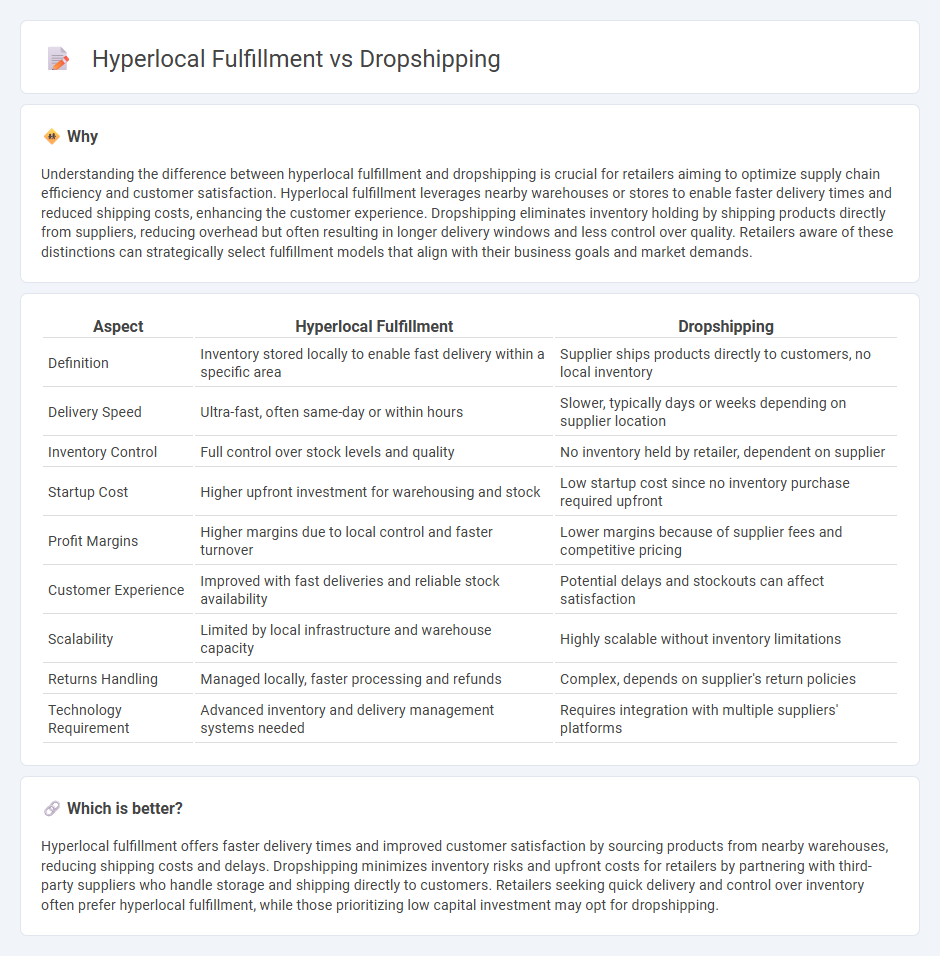
Hyperlocal fulfillment leverages nearby warehouses or stores to deliver products rapidly to customers, enhancing speed and reducing shipping costs, while dropshipping minimizes inventory risks by forwarding orders directly from suppliers to buyers without holding stock. Retailers utilize hyperlocal fulfillment to boost customer satisfaction through faster delivery, whereas dropshipping offers scalability with minimal upfront investment. Explore the advantages and limitations of each model to optimize your retail strategy.
Why it is important
Understanding the difference between hyperlocal fulfillment and dropshipping is crucial for retailers aiming to optimize supply chain efficiency and customer satisfaction. Hyperlocal fulfillment leverages nearby warehouses or stores to enable faster delivery times and reduced shipping costs, enhancing the customer experience. Dropshipping eliminates inventory holding by shipping products directly from suppliers, reducing overhead but often resulting in longer delivery windows and less control over quality. Retailers aware of these distinctions can strategically select fulfillment models that align with their business goals and market demands.
Comparison Table
| Aspect | Hyperlocal Fulfillment | Dropshipping |
|---|---|---|
| Definition | Inventory stored locally to enable fast delivery within a specific area | Supplier ships products directly to customers, no local inventory |
| Delivery Speed | Ultra-fast, often same-day or within hours | Slower, typically days or weeks depending on supplier location |
| Inventory Control | Full control over stock levels and quality | No inventory held by retailer, dependent on supplier |
| Startup Cost | Higher upfront investment for warehousing and stock | Low startup cost since no inventory purchase required upfront |
| Profit Margins | Higher margins due to local control and faster turnover | Lower margins because of supplier fees and competitive pricing |
| Customer Experience | Improved with fast deliveries and reliable stock availability | Potential delays and stockouts can affect satisfaction |
| Scalability | Limited by local infrastructure and warehouse capacity | Highly scalable without inventory limitations |
| Returns Handling | Managed locally, faster processing and refunds | Complex, depends on supplier's return policies |
| Technology Requirement | Advanced inventory and delivery management systems needed | Requires integration with multiple suppliers' platforms |
Which is better?
Hyperlocal fulfillment offers faster delivery times and improved customer satisfaction by sourcing products from nearby warehouses, reducing shipping costs and delays. Dropshipping minimizes inventory risks and upfront costs for retailers by partnering with third-party suppliers who handle storage and shipping directly to customers. Retailers seeking quick delivery and control over inventory often prefer hyperlocal fulfillment, while those prioritizing low capital investment may opt for dropshipping.
Connection
Hyperlocal fulfillment and dropshipping connect by enabling retailers to deliver products quickly while minimizing inventory costs. Hyperlocal fulfillment leverages nearby warehouses or stores to ship items rapidly, aligning with dropshipping's model where suppliers directly dispatch goods to customers. This synergy enhances supply chain efficiency, reduces delivery times, and supports local commerce growth.
Key Terms
Inventory Management
Dropshipping eliminates the need for inventory storage by directly shipping products from suppliers to customers, minimizing overhead costs and reducing inventory risk. Hyperlocal fulfillment focuses on maintaining a localized inventory near the customer base, enabling faster delivery times and better control over stock levels. Explore how these models impact your supply chain efficiency and customer satisfaction by learning more about advanced inventory management strategies.
Delivery Speed
Dropshipping relies on third-party suppliers shipping products directly to customers, often resulting in longer delivery times due to varied sourcing locations. Hyperlocal fulfillment leverages nearby warehouses or stores to ensure faster delivery, typically within hours or a day, enhancing customer satisfaction. Explore the differences in delivery speed to choose the best fulfillment model for your business needs.
Supplier Proximity
Dropshipping relies on suppliers shipping products directly to customers, often from distant locations, which can result in longer delivery times and higher shipping costs. Hyperlocal fulfillment emphasizes supplier proximity by sourcing and delivering products from nearby warehouses or stores, ensuring faster delivery and lower shipping expenses. Explore the benefits and challenges of supplier proximity in both models to optimize your supply chain strategy.
Source and External Links
What Is Dropshipping and How Does It Work? (2025) - Shopify - Dropshipping is a business model where you partner with suppliers who store, pack, and ship products directly to customers after you sell them through your online store, handling most logistical tasks for you.
What Is Dropshipping and How Does It Work? - Wix.com - Dropshipping allows retailers to sell products without holding inventory by buying items from suppliers only when customers place orders, outsourcing production, warehousing, and shipping.
Drop shipping - Wikipedia - Drop shipping is a retail fulfillment method where sellers forward customer orders to manufacturers or wholesalers who ship directly to customers, enabling sellers to avoid inventory management and storage costs.
 dowidth.com
dowidth.com